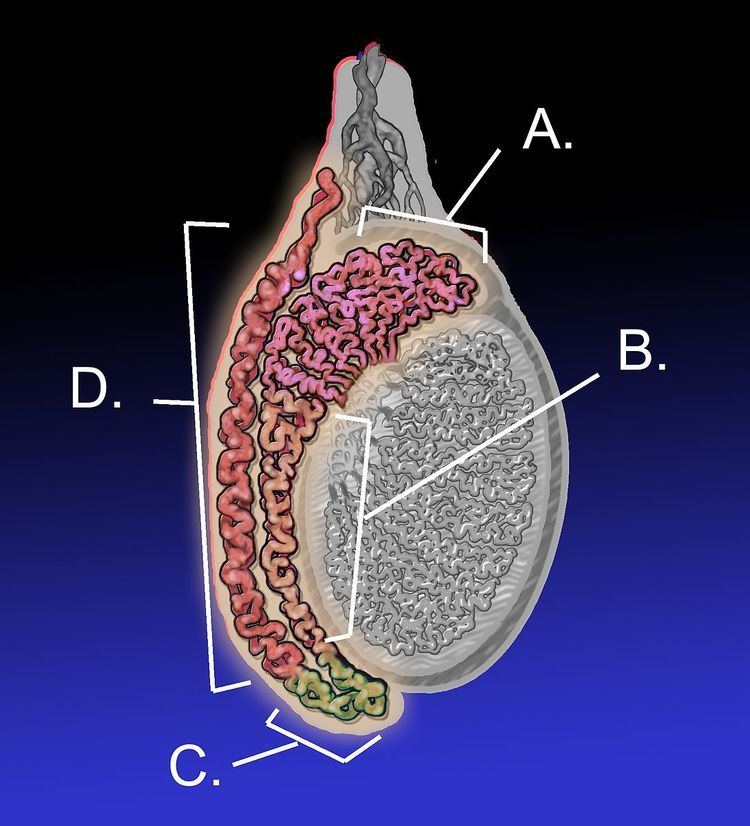Precursor Wolffian duct Latin Epididymis | Vein Pampiniform plexus MeSH A05.360.444.371 | |
 | ||
The epididymis (/ɛpᵻˈdɪdᵻmɪs/; plural: epididymides /ɛpᵻdᵻˈdɪmədiːz/ or /ɛpᵻˈdɪdəmɪdiːz/) is a tube that connects a testicle to a vas deferens in the male reproductive system. It is present in all male reptiles, birds, and mammals. It is a single, narrow, tightly-coiled tube (in adult humans, six to seven meters in length) connecting the efferent ducts from the rear of each testicle to its vas deferens.
Contents
Structure
The epididymis can be divided into three main regions:
In reptiles, there is an additional canal between the testis and the head of the epididymis and which receives the various efferent ducts. This is, however, absent in all birds and mammals.
Histology
The epididymis is covered by a two layered pseudostratified epithelium. The epithelium is separated by a basement membrane from the connective tissue wall which has smooth muscle cells. The major cell types in the epithelium are:
Stereocilia
The stereocilia of the epididymis are structures which aid in absorption. They are long cytoplasmic projections that have no motility.
Unlike the stereocilia of the inner ear, which play a role in hearing, stereocilia in the epididymis are more like the long, absorptive microvilli of other epithelia. These membrane extensions increase the surface area of the cell, allowing for greater absorption and secretion.
The stereocilia in the epididymis are shaped by an internal actin network with no microtubule structure, and unlike true cilia are non-motile. Because sperm are initially nonmotile as they leave the seminiferous tubules, large volumes of fluid are secreted to propel them to the epididymis. The core function of the stereocilia is to resorb 90% of this fluid as the spermatozoa start to become motile. This absorption creates a fluid current that moves the immobile sperm from the seminiferous tubules to the epididymis. Spermatozoa do not reach full motility until they reach the vagina, where the alkaline pH is neutralized by acidic vaginal fluids.
Development
In the embryo, the epididymis develops from tissue that once formed the mesonephros, a primitive kidney found in many aquatic vertebrates. Persistence of the cranial end of the mesonephric duct will leave behind a remnant called the appendix of the epididymis. In addition, some mesonephric tubules can persist as the paradidymis, a small body caudal to the efferent ductules.
A Gartner's duct is a homologous remnant in the female.
Role in storage of sperm and ejaculant
Spermatozoa formed in the testis enter the caput epididymis, progress to the corpus, and finally reach the cauda region, where they are stored. Sperm entering the caput epididymis are incomplete—they lack the ability to swim forward (motility) and to fertilize an egg. It stores the sperm for 2–3 months. During their transit in the epididymis, sperm undergo maturation processes necessary for them to acquire these functions. Final maturation is completed in the female reproductive tract (capacitation).
The epididymis secretes some proteins that blocks the receptors on the plasma membrane of sperm head which renders sperm infertile inside the male tract (decapacitation).
During ejaculation, sperm flow from the lower portion of the epididymis (which functions as a storage reservoir). They have not been activated by products from the prostate gland, and they are unable to swim, but are transported via the peristaltic action of muscle layers within the vas deferens, and are mixed with the diluting fluids of the seminal vesicles and other accessory glands prior to ejaculation (forming semen).
The epithelial cells of the epididymis possess numerous apical modifications that are often referred to as stereocilia, as under the light microscope they look like cilia. However, as electron microscopy has revealed them to be structurally and functionally more similar to microvilli, some now refer to them as stereovilli.
Inflammation
An inflammation of the epididymis is called epididymitis. It is much more common than testicular inflammation, termed orchitis.
Surgical removal
Epididymotomy is the placing of an incision into the epididymis and is sometimes considered as a treatment option for acute suppurating epididymitis. Epididymectomy is the surgical removal of the epididymis sometimes performed for post-vasectomy pain syndrome and for refractory cases of epididymitis.
Ghostbusters II
In the 1989 film, Egon Spengler (played by the late Harold Ramis) responds to a jibe made by Peter Venkman (Bill Murray) about his female colleagues being attracted to the size of his cranium with "I think they're more interested in my epididymis."
